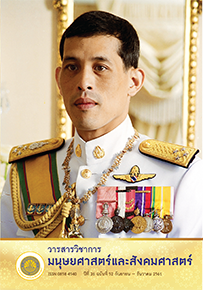Impact of Leadership on Core Competencies: A Case Study of Burapha University
Main Article Content
Abstract
The purpose of this research were to study the leadership level of Burapha University’s administrators classified by demographic factors and to analyze the relationship between leadership and subordinates’ core competencies. Moreover, this study compared the different degrees of the subordinates’ core competencies on each type of leadership. There were 3 types of leadership in this study which were as follows transformational leadership, transactional leadership and laissez-faire leadership. Questionnaires were used to collect data from 336 staffs in Burapha University by Ratio Sampling method. One-Way ANOVA and Independent sample t-test were utilized to test the difference of the average degree of leadership and the Pearson’s correlation coefficient were employed to examine the relationships between leadership and subordinates’ core competencies. The study revealed that transformational leadership, transactional leadership and laissez-faire leadership were positively correlated with the subordinates’ core competencies. The result also showed that the level of transactional leadership of administrators who have been working at Burapha University for more than 10 years but less than 20 years was higher than that of administrators who have been working for less than 10 years. In addition, the levels of subordinates’ core competencies under the administrators who show with transactional leadership style were higher than those of the other two leadership styles. The results of this study can be used as a guideline for the administrators to develop and apply their leadership styles to fit their organization environment.
Downloads
Article Details
บทความทุกบทความเป็นลิขสิทธิ์ของวารสารวิชาการมนุษยศาสตร์และสังคมศาสตร์ มหาวิทยาลัยบูรพาเท่านั้น
References
โชติกา พิริยนนทกุล. (2555). การนำระบบสมรรถนะมาใช้ในการประเมินผลการปฏิบัติงานของบริษัทระยองเพียวริฟายเออร์ จำกัด (มหาชน). การค้นคว้าอิสระบริหารธุรกิจมหาบัณฑิต, คณะบริหารธุรกิจ, มหาวิทยาลัยเกษตรศาสตร์.
จันทนา แสนสุข. (2557). ปัจจัยที่เป็นเหตุและผลของความสามารถภาวะผู้นำเชิงกลยุทธ์ของสถาบันอุดมศึกษาในไทย. วารสาร
สมาคมนักวิจัย, 19 (1), 35.
นพพร พุกกะพันธุ์. (2544). ภาวะผู้นำและการจูงใจ. กรุงเทพฯ: จามจุรีโปรดักท์.
พันทิวา สุพัฒนาภรณ์. (2556). ภาวะผู้นำที่ส่งผลต่อวัฒนธรรมองค์กร กรณี บริษัท ไทย อกริ ฟู้ดส์ จำกัด(มหาชน). ภาคนิพนธ์ศิลป
ศาสตรมหาบัณฑิต, สาขาวิชาการสื่อสารประยุกต์, คณะภาษาและการสื่อสาร, สถาบันบัณฑิตพัฒนบริหารศาสตร์.
มหาวิทยาลัยบูรพา. (2559). ระบบบุคลากรอิเล็กทรอนิกส์. วันที่ค้นข้อมูล 6 พฤษภาคม 2559, จากhttps://person.buu.ac.th/codes/index.php,
รภัสศา พิมพา. (2557). ภาวะผู้นำของนิสิตครูหลักสูตรการศึกษาบัณฑิต (กศ.บ. 5 ปี) มหาวิทยาลัยศรีนครินทรวิโรฒ. ปริญญา
นิพนธ์การศึกษามหาบัณฑิต, สาขาวิชาการบริหารการศึกษา, บัณฑิตวิทยาลัย, มหาวิทยาลัยศรีนครินทรวิโรฒ.
สำนักงานคณะกรรมการข้าราชการพลเรือน. (2553). การปรับใช้สมรรถนะในการบริหารทรัพยากรมนุษย์. วันที่ค้นข้อมูล 11 มีนาคม
2559, จาก https://osc.go.th/veform/PDF/competency.pdf.
Bass, B. M., & Avolio, B. J. (1994). Improving Organizational Effectiveness Through Transformational Leadership.
California: SAGE.
Boyatzis, R. E. (1982). The competent manager: a model for effective performance. London: Wiley.
Carnegie, D. (2009). Leadership Mastery: How to Challenge Yourself and Others to Greatness. New York: Dale Carnegie & Associates, Inc.
Dubois, D. D., & Rothwell, J. W. (2004). Competency – Based Human Resource Management. California: Davies –
Black Publishing.
Dubrin, A. (2013). Leadership: Research Findings, Practice, and Skills (5th ed.). Boston: Houghton Mifflin.
Farmer, A. W. (2010). The Perception of teachers and Principals on Leaders’ Behavior Informed by 13 Core Competencies and Its Relationship to Teacher Motivation. Doctor of Education Dissertation in Major, Leadership
and Policy Studies, The University of Memphis.
George, J. M., & Jones, G. (2005). Understanding and Managing Organizational Behavior (4th ed.). New Jersey: Prentice-Hall.
Hamel, G., & Prahalad, C. K. (1994). Competing for the Future. Massachusetts: Harvard Business School Press.
Hellriegel, D., Jackson, S. E., & Slocum, J. W., Jr. (2005). Management: A Competency-Based Approach. Ohio: South-Western.
Krejcie, R. V., & Morgan, D. W. (1970). Determining Sample Size for Research Activities. Educational and psychological measurement, 30, 607-610.
Lewin, K. (1997). Resolving Social Conflicts Field Theory in Social Science. New York: Happer.
Mandell, B., & Pherwani, S. (2003). Relationship between Emotional Intelligence and Transformational Leadership Style: A Gender Comparison. Journal of Business and Psychology, 17(3), 387-404.
Maxwell, J. C. (1998). The 21 Irrefutable Laws of Leadership: Follow Them and People will Follow You. Tennessee: Thomas Nelson, Inc.
McClelland, D. C. (1973). Testing for Competence rather than Intelligence. American Psychologist, 28(1), 1-14.
Northouse, P. G. (2013). Leadership: Theory and Practice (6th ed.). California: SAGE.
Robbins, S. P., & Coulter, M. (2002). Management (7th ed.). New Jersey: Prentice-Hall.
Rowe, W. G., & Guerrero, L. (2013). Case in Leadership (3rd ed.). California: SAGE.
Spencer, L. M., & Spencer, S. M. (1993). Competence at work. New York: Wiley.
Stogdill, R. M. (1974). Handbook of leadership. New York: Free Press.
Storey, J. (2011). Leadership in Organizations: Current Issues and Key Trends (2nd ed.). New York: Routledge.


